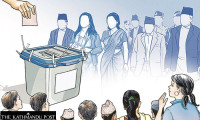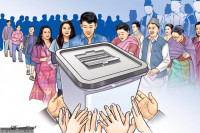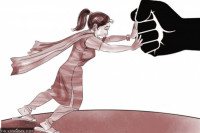National
Air Dynasty crash in Nepal raises a question—again—why so many choppers are going down in the country
At least 19 fatal crashes of helicopters have taken place across the country since the aviation authorities started keeping records in 1966.
Sangam Prasain
The crash of an Air Dynasty helicopter in the eastern mountain region of Taplejung on Wednesday—killing all seven aboard—is the second fatal chopper crash in Nepal’s skies in just six months. At least 19 fatal crashes of helicopters have taken place across the country since the aviation authorities started keeping records in 1966.
Wednesday’s accident comes as another blow to the country’s flight safety record just as the Civil Aviation Authority of Nepal, the country’s aviation regulator, has been attempting to introduce—but struggling to implement—safety reforms. The tragedy, which killed the country’s tourism minister and a prominent businessman along with other officials, has once again raised a question: why are so many helicopters crashing in the country?
The crash of the Air Dynasty chopper wasn't the first one that occurred during inclement weather conditions. Three years ago, a Fishtail Air helicopter crashed in Nuwakot, also killing all seven people on board. Last year, an Altitude Air chopper crashed in Nuwakot, killing six people.
What’s common in the three recent crashes is that the captain of all the flights had violated standard operating procedures for choppers—by entering clouds. What’s also common, aviation experts said, is a certain behavioural attitude the pilots have exhibited in the face of adverse weather.

When the government’s investigation report on Fishtail Air crash was released, it said that the flight captain’s social and professional obligation to evacuate a post-maternity sick woman and her infant to a hospital in Kathmandu led him to lose situational awareness, and therefore the control of the chopper, before entering heavy clouds over Kakani.
Although the official report into the Altitude Air crash is yet to be made public, initial investigation suggests that the chopper crashed during bad weather after the captain entered the clouds and hit a steep hill.
Wednesday’s crash, based on eyewitness reports and an official statement by aviation authorities appears to be no different: the pilot, 26-year-old Prabhakar KC, had entered a blanket of clouds and lost control of the chopper before crashing into the cliff.
KC, the captain of the Air Dynasty chopper that crashed on Wednesday, initially appeared to acknowledge that he was unable to take off. “Heavy snowfall. Not able to airborne,” KC, according to airport officials, who confirmed that the area had a strong wind during the afternoon and it was covered with dense clouds.
But what made him change his decision abruptly raises a big question mark, according to Gunjaman Lama, a retired brigadier general in the Nepal Army, who inspects helicopter operations for CAAN.
Lama, who has a long experience of flying VIPs and VVIPs in the Nepal Army’s Super Puma helicopter, said the new generations of pilots, particularly in helicopters operated by private companies, often tend to agree with everything they are told—or asked to do when it comes to flight procedures.
“Although they are trained and professionally taught to say “no” when the situation is not favourable, no one follows the rule,” Lama said.
Under heavy snowfall, KC appeared to have taken an uncalculated risk, said a senior safety official of CAAN. “We don’t know whether the pilot was forced to fly or if he made a decision to take the risk himself,” the official said, speaking on condition of anonymity because a formal investigation is ongoing.
The country’s aviation regulator has time and again instructed chopper pilots to strictly follow one rule: do not enter the cloud. Just last Thursday, CAAN had posted an image on its Twitter page, reminding pilots that it is not safe to enter clouds.
“But the mistakes are committed repeatedly,” said Lama.
In the wake of increasing chopper accidents, the aviation regulator in 2016 had issued a circular, warning fixed-wing plane and chopper pilots that their licence would be scrapped if they were found entering clouds during flights. But recent crashes show that the warnings have gone unheeded, especially on flights operated by younger pilots with fewer hours of flying experience.
A senior pilot for Kailash Helicopters, a privately owned chopper company, said KC was too junior to handle Wednesday’s VIP flight, but he could not have intentionally entered the clouds.
“KC was a disciplined professional and he was not an aggressive pilot,” said Ashish Sherchan, who owns Kailash Helicopters. “But he may have felt the pressure to operate the chopper and fly them to a lower altitude destination because he was carrying high-profile individuals, including his own boss.”
Ang Tshering Sherpa, the managing director of Yeti Airlines, who was on board the chopper on Wednesday, also owned the Air Dynasty fleet.

Security personnel from Nepal Army unload the remains of the people killed in Wednesday's crash. [Post Photo: Hemanta Shrestha]
There are two sets of rules for flying an aircraft: first, through visual direction, a set of regulations under which a pilot operates an aircraft in weather conditions generally clear enough to allow the pilot to see where the aircraft is going. The second is the Instrument Flight Rules, under which an aircraft is operated using flight technology. In Nepal, almost all flights in high-altitude areas are operated under the visual flight rule, which means the pilot has complete control and decision-making ability to guide the aircraft.
While the country has seen an increase in helicopter accidents in recent years, at the same time, there have been fewer accidents involving twin-engine passenger aircraft. Following a ban by the European Union on all Nepal-based airlines in 2013, the Nepal government introduced stringent measures to improve safety standards in all commercial and private airlines. However, the newly introduced regulations did not apply to helicopter operators and pilots.
“We are equally focused on maintaining the safety of both chopper and twin-engine aircraft operations,” said Rajan Pokhrel, who oversees the country’s aviation safety department. “But, since the operational requirement of choppers are different and are basically chartered, the operators must be more liable for passenger safety.”
Helicopters in Nepal typically operate in challenging topography, and the flights operating during inclement weather are particularly vulnerable.
In the last two years, at least four new helicopter companies have started operations in Nepal, bringing the total number of private chopper companies to 10.
To become a chopper pilot, one must attend the Commercial Pilot License training and complete no less than 150 hours of flight. After that, the trainee must apply for type rating from CAAN. After flying 600 hours with seniors or a pilot-in-command, the candidate becomes eligible to fly a helicopter in a single seat. However, to fly in high-altitude areas, the pilot must complete an additional 600 hours of flying with a pilot-in-command.
KC, the Air Dynasty pilot, has completed more than 2,500 hours and had been flying for only a year as a senior pilot. A pilot can graduate to a senior position after completing at least 1,40o flying hours.
Lama, the retired Nepal Army pilot, said younger pilots should be taught to acknowledge risks before they fly, and they have to learn to push back when there is pressure to operate during inclement weather. “What they have to learn is,” he said, “they always have another day to fly.”




 19.12°C Kathmandu
19.12°C Kathmandu















